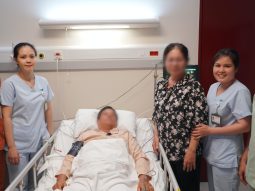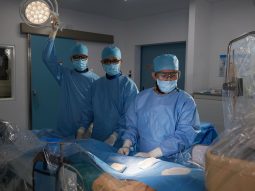Doctors in the Obstetrics & Gynaecology Department at FV Hospital successfully delivered the baby of a Cambodian mother carrying an 8 kg uterine fibroid. Remarkably, the baby positioned within the fibroid in the womb, was born healthy. The mother’s health was swiftly stabilised, and she was discharged in good health along with her newborn.
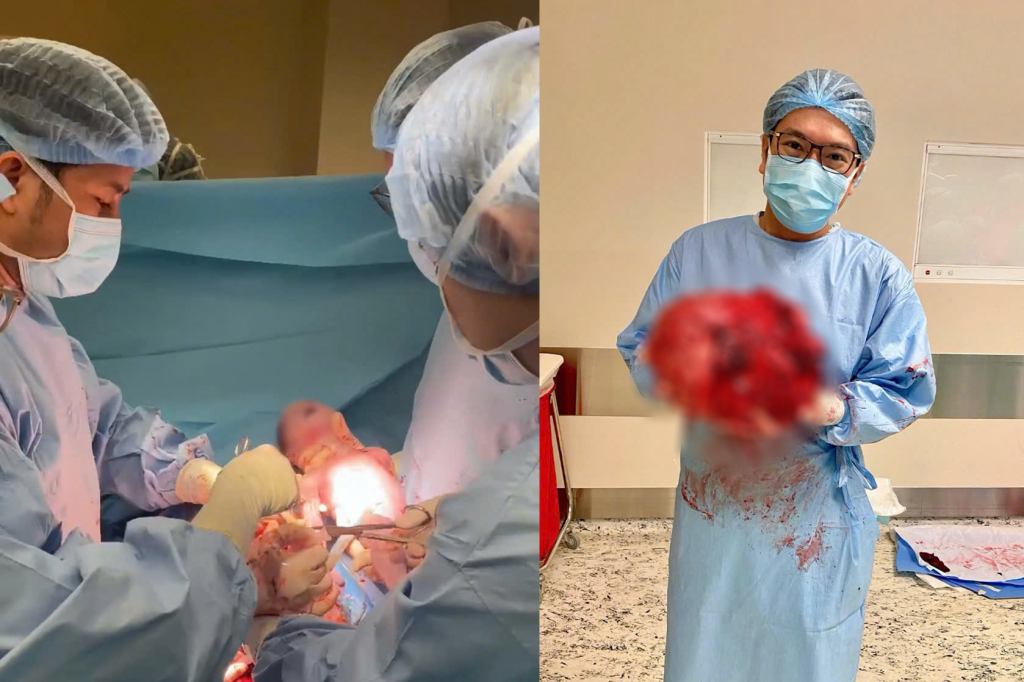
According to Vo Trieu Dat, MD, MSc, Head of Obstetrics & Gynaecology Department at FV Hospital, this was a rare and complex case, as the expectant mother was carrying a large fibroid and was in a relatively weak condition. A team of FV obstetricians, alongside the anaesthesia and resuscitation team, closely monitored the patient from the early weeks of pregnancy, meticulously planning to support the foetus and perform a caesarean delivery while also removing the fibroid.
The expectant mother bravely faced significant risks to fulfil her dream of becoming a mother.
In April 2023, Ms B.S., a 37-year-old Cambodian woman, visited FV Hospital for a consultation and was diagnosed with multiple uterine fibroids. Dr Vo Trieu Dat, MD, MSc noted that she had several fibroids, the largest weighing over 2 kg and extending above her navel. She was advised to undergo a hysterectomy and fibroid removal promptly to prevent complications. However, she hesitated and returned to her country due to work commitments.
In June 2023, Ms S. returned to FV Hospital as an emergency case with severe abdominal pain. Doctors were surprised to discover that she was approximately eight weeks pregnant. Given the pain was likely a complication from the fibroid, Dr Dat recommended terminating the pregnancy and advised urgent surgery to treat the fibroid. However, once again, she chose not to proceed with treatment.

In April 2024, Ms. S. returned to FV Hospital, and once again, doctors were astonished to find that she was pregnant for a second time. “Our team was extremely concerned, as the patient was pregnant again and the fibroid had continued to grow,” recalled Dr Dat. Fortunately, this pregnancy progressed stably, with no abdominal pain, vomiting, or bleeding.
Dr Dat explained to Ms. S. the significant risks and unpredictable complications of being pregnant with a large fibroid. A uterus containing both a growing baby and expanding fibroid could compress surrounding organs, potentially causing tissue necrosis, bleeding, and severe abdominal pain – all of which could be life-threatening for both mother and baby.
After hearing Dr Dat’s advice, Ms. S. expressed her determination to keep the pregnancy, accepting the potential risks to her own life. Her profound desire to become a mother led her to forgo the recommended fibroid removal surgery.
In response to her courageous decision, Dr Dat and the FV Obstetrics & Gynaecology team devised a comprehensive plan to support her throughout this exceptional and high-risk pregnancy.
The obstetrics team closely supported the mother throughout her extraordinary pregnancy.
Ms. S. was closely monitored by the FV Hospital obstetrics team, with regular health checks and personalised nutritional guidance to support stable foetal development. “As both an obstetrician and a fibroid specialist, I was anxious and worried every day from the moment I learned she was pregnant,” shared Dr Dat.
As the foetus grew, so did the fibroid, leaving Ms. S. to struggle to eat, losing sleep, and experience severe weakness. Despite being pregnant, her weight was just over 40 kg. The FV medical team was constantly by her side, encouraging her to prioritise her health to support both a safe delivery and sufficient nutrition and weight gain for her baby.
Although her health was fragile and mobility challenging due to carrying both a foetus and a large fibroid, Ms. S. remained optimistic. She lived as normally as possible, following every medical recommendation, determined to sustain her child with all her inner strength.
From the 25th week, Ms. S. chose to stay near FV Hospital for regular monitoring and immediate care if needed. Observing her deteriorating physical condition—barely able to eat or drink – Dr Dạt planned to deliver the baby at 36 weeks via surgery, which would also involve removing the fibroid to protect both mother and child from further health risks.
The caesarean delivery required a team of five doctors.
The surgical team, led by Dr Dat, consisted of 7 members: 3 obstetricians, 2 anaesthesiologists, and 2 surgical assistants. This was expected to be a major operation with a high risk of blood loss and numerous potential complications. Given the possibility of the patient’s condition becoming critical at any moment, preparations were made with the utmost care and precision.
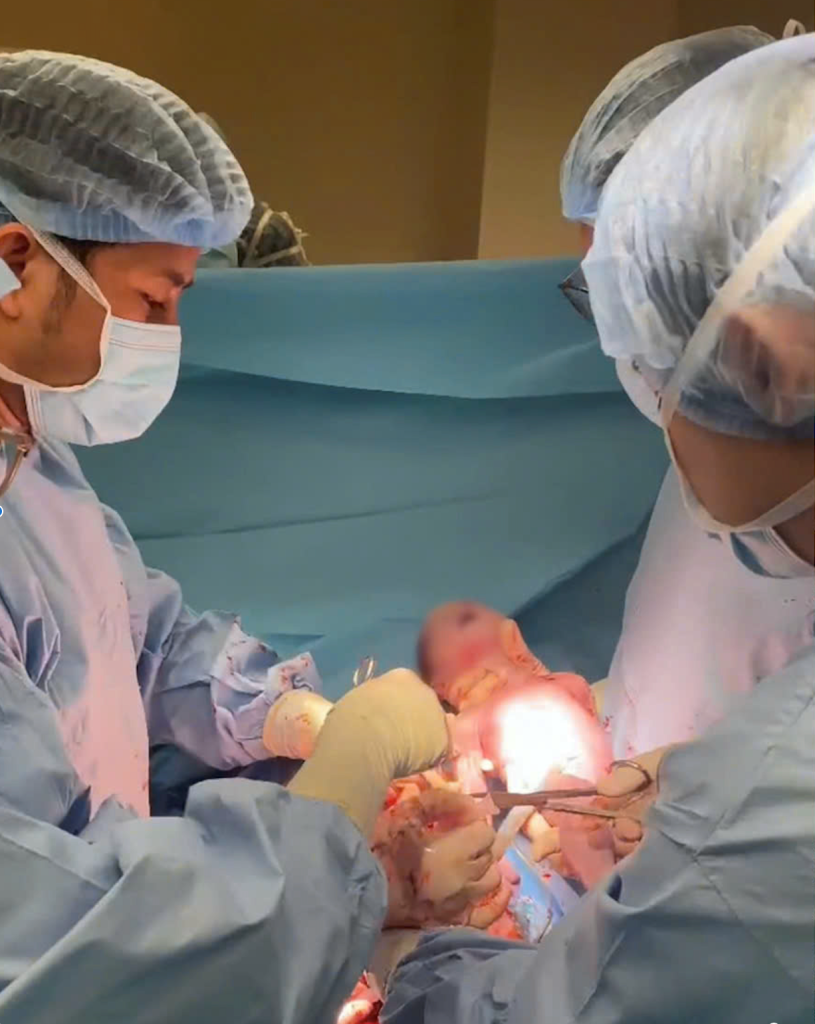
Due to the patient’s uterus being hardened and thickened up to 10 cm, Dr Dạt had to perform a T-shaped incision to safely access and deliver the baby. After 150 minutes of intense surgery, a healthy baby was born, weighing 2.4 kg. The surgical team then proceeded with a partial hysterectomy to remove the fibroid while preserving the patient’s cervix.
The removed fibroid weighed 8 kg— the largest Dr Dat had ever encountered. The surgical team had to administer nearly 1 litre of blood to Ms S. during the operation.

Following the surgery, the patient was monitored around the clock. Thanks to the attentive care of the FV medical team, her health improved rapidly. By the third day, she was able to walk and was discharged just nine days later.
On the day of her discharge, Ms. S. and her family were overjoyed, and the entire FV obstetrics team shared in their relief and happiness. In a heartfelt letter to Dr Dat and the team, the patient’s husband, who had remained by his wife’s side throughout the challenging pregnancy, expressed his gratitude: “For the nearly two weeks that my family has been in this emergency room, we have been thrilled and warm to receive treatment and have been the heroism and great đeication of Dr VO TRIEU DAT and the team medical FV hospital.”
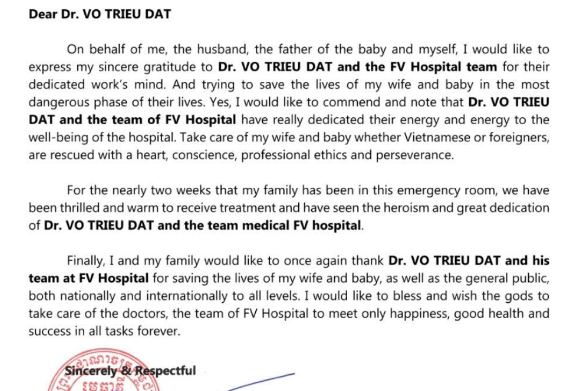
According to Vo Trieu Dat, MD, MSc, it is relatively common for women to be pregnant while having uterine fibroids. In some cases, complications from the fibroid may necessitate terminating the pregnancy. However, most pregnancies proceed relatively smoothly and safely.
Pregnant women with uterine fibroids require thorough examination and close monitoring by their doctors. If the fibroid is positioned in the birth canal, a caesarean section will be necessary for delivery.
Some potential complications can occur, such as rapid fibroid growth that may compress the foetus, or the fibroid necrosis, which causes severe abdominal pain and may force the pregnancy to be terminated. Therefore, regular monitoring is essential to prevent any unfortunate incidents.
Dr Dat also noted that a caesarean section for a pregnant woman with uterine fibroids requires meticulous preparation, especially when the fibroid is large. “When the uterus is fibrotic, there will be significant vascular proliferation. If the incision is made incorrectly, it could result in excessive bleeding, affecting the patient’s hemodynamic. Additionally, there are many other unpredictable risks, so the preparation for the surgery must be extremely careful and thorough,” explained Dr Vo Trieu Dat.

 Vi
Vi 
